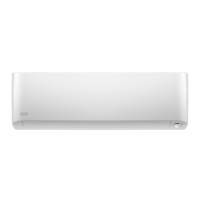
Do you have a question about the Bryant 619PHA Series and is the answer not in the manual?
| Brand | Bryant |
|---|---|
| Model | 619PHA Series |
| Category | Air Handlers |
| Language | English |
General safety precautions for installation and servicing of HVAC equipment.
Details risks and precautions for electrical hazards during servicing.
Outlines hazards related to explosion risks with certain gases.
Warns about practices that could lead to equipment damage or malfunction.
Explains the structure and components of the indoor model number.
Details specifications for the indoor coil, including rows and fins per inch.
Provides performance data for the indoor unit, such as airflow and sound pressure.
Detailed dimensional data for the 09K and 12K indoor unit models.
Detailed dimensional data for the 18K and 24K indoor unit models.
Specifies required clearances around the indoor unit for proper operation.
Provides guidelines and recommendations for power and communication wiring.
Illustrates the electrical connection diagram for 208-230V systems.
Detailed wiring diagram for the 09K and 12K indoor unit models.
Detailed wiring diagram for the 18K and 24K indoor unit models.
Details specifications for the indoor fan and fan motor components.
Illustrates the refrigeration cycle for heat pump operation.
Details the deep vacuum method for system evacuation and its importance.
Outlines the alternate triple evacuation method for system evacuation.
Provides guidance on checking refrigerant tubing for proper installation and condition.
Covers safety features like compressor delay and overheat protection.
Explains the various display functions and icons for unit status.
Details conditions for compressor operation and shutdown in cooling mode.
Explains how the indoor fan speed is regulated in cooling mode, including AUTO fan.
Protects compressor from high condenser or low evaporator temperatures.
Details conditions for compressor operation and shutdown in heating mode.
Explains how the indoor fan speed is regulated in heating mode, including AUTO fan.
Crucial safety warning regarding high voltage in capacitors before troubleshooting.
Lists indoor unit error codes and their corresponding error information and solutions.
Guides on handling undefined error codes or garbled displays.
Troubleshooting steps for issues not indicated by error codes, focusing on remote maintenance.
Details troubleshooting steps for electrical circuit issues during field maintenance.
Details troubleshooting steps for refrigerant circuit issues during field maintenance.
Covers troubleshooting related to load conditions, bolts, shipping plates, and piping contact.
Outlines common procedures for checking temperature sensors and the compressor.
Diagnosis and solution for EEPROM parameter errors on indoor/outdoor PCBs.
Provides remarks and guidance for testing communication errors using a multimeter.
Step-by-step guide for removing the front panel of the indoor unit (09K-12K).
Contains a table of temperature sensor resistance values for T1, T2, T3, T4.
